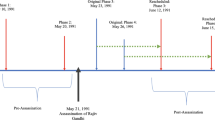Abstract
The politically involved members of the mass public have commonly been described as having more sophisticated awareness of political issues and a greater ability to use issues in forming their evaluations of candidates. This paper briefly reviews the issue-voting literature which comes to that conclusion, and proposes that the politically involved people might also be more subject to projection in the formation of their political perceptions. A model of perception that includes both projection and inference processes is estimated using data from the 1972–74–76 CPS Panel Study. Separate estimations for the involved and uninvolved strata reveal higher projection coefficients for the more involved on the more ambiguous issues.
Similar content being viewed by others
References
Bem, Daryl J. (1970).Beliefs, Attitudes, and Human Affairs. Belmont, Calif.: Brooks/Cole.
Berelson, Bernard, Lazarsfeld, Paul F., and McPhee, William N. (1954).Voting. Chicago: University of Chicago.
Bishop, George F., Tuchfarber, Alfred J., and Oldenick, Robert W. (1978). Change in the structure of political attitudes: The nagging question wording.American Journal of Political Science 22: 250–269.
Brody, Richard A., and Page, Benjamin I. (1972). The assessment of policy voting.American Political Science Review 66: 450–458.
Bruner, Jere (1978). Make your own Nixon: Projection of candidate issue stands as a fly in the ointment of issue voting. Paper prepared for delivery at the Annual Meeting of the Midwest Political Science Association, Chicago.
Campbell, Angus, Converse, Philip E., Miller, Warren E., and Stokes, Donald E. (1960).The American Voter. New York: John Wiley and Sons.
Carmines, Edward G., and Stimson, James A. (1980). The two faces of issue voting.American Political Science Review 74: 78–91.
Converse, Philip E. (1964). The nature of belief systems in mass publics. In David Apter (ed.),Ideology and Discontent, pp. 206–256. New York: Free Press.
Converse, Philip E. (1966). Information flow and the stability of partisan attitudes. In Angus Campbell, Philip E. Converse, Warren E. Miller, and Donald E. Stokes (eds.),Elections and the Political Order, pp. 136–157. New York: John Wiley and Sons.
Feldman, Stanley, and Conover, Pamela Johnston (1983). Candidates, issues, and voters.Journal of Politics 45: 810–839.
Festinger, Leon (1957).A Theory of Cognitive Dissonance. Evanston, Ill.: Row-Peterson.
Fiorina, Morris P. (1981).Retrospective Voting in American National Elections. New Haven: Yale University Press.
Gant, Michael M. (1985). The irrelevance of abstract conceptualization for policy voting.Polity 8: 149–160.
Granberg, Donald (1985). An anomaly in political perception.Public Opinion Quarterly 49: 504–516.
Hamill, Ruth C., Lodge, Milton, and Blake, Frederick (1985). The breadth, depth, and utility of class, partisan, and ideological schemata.American Journal of Political Science 29: 850–870.
Hinckley, Barbara, Hofstetter, C. Richard, and Kessel, John H. (1974). Information and the vote: A comparative election study.American Politics Quarterly 2: 131–158.
Key, V. O., Jr. (1949).Southern Politics in State and Nation. New York: Knopf.
Key, V. O., Jr. (1966).The Responsible Electorate: Rationality in Presidential Voting, 1936–1960. New York: Vintage Books.
King, Gary (1986). How not to lie with statistics: Avoiding common mistakes in quantitative political science.American Journal of Political Science 30: 666–687.
Lodge, Milton G., and Hamill, Ruth (1986). A partisan schema for political information processing.American Political Science Review 80: 521–540.
Luttbeg, Norman R., and Gant, Michael M. (1985). The failure of liberal/conservative ideology as a cognitive structure.Public Opinion Quarterly 49: 80–93.
Margolis, Michael (1977). From confusion to confusion: Issues and voters, 1952–1972.American Political Science Review 71: 31–43.
Markus, Gregory B. (1979).Analyzing Panel Data. Beverly Hills, California: Sage.
Markus, Gregory B. (1982). Political attitudes in an election year.American Political Science Review 76:538–560.
Markus, Gregory B. and Converse, Philip E. (1979). A dynamic simultaneous equation model of electoral choice.American Political Science Review 73: 1055–1070.
Miller, Arthur H., Miller, Warren E., Rusk, Jerrold G., and Wolfe, Arthur C. (1976). A majority party in disarray: Policy polarization in the 1972 election.American Political Science Review 76: 753–778.
Miller, Arthur H., Wattenberg, Martin P., and Malunchuk, Oksana (1986). Schematic assessments of presidential candidates.American Political Science Review 80: 521–540.
Nie, Norman H., with Andersen, Kristi (1974). Mass belief systems revisited: Political change and attitude structure.Journal of Politics 36: 540–587.
Nie, Norman H., Verba, Sidney, and Petrocik, John R. (1979).The Changing American Voter. Cambridge, Mass.: Harvard University Press.
Page, Benjamin I., and Brody, Richard A. (1972). Policy voting and the electoral process.American Political Science Review 66: 979–995.
Piereson, James E. (1978). Issue alignment and the American party system.American Politics Quarterly 6: 275–307.
Pomper, Gerald M. (1972). From confusion to clarity: Issues and American voters, 1952–1968.American Political Science Review 66: 415–428.
Pomper, Gerald M. (1975).Voter's Choice. New York: Harper and Row.
Repass, David E. (1971). Issue salience and party choice.American Political Science Review 65: 389–400.
Schneider, David J., Hastorf, Albert H., and Ellsworth, Phoebe C. (1979).Person Perception. Reading, Mass.: Addison-Wesley.
Shaffer, Stephen D. (1981). Balance theory and political cognitions.American Politics Quarterly 9: 291–320.
Stimson, James A. (1975). Belief systems: constraint, complexity, and the 1972 election.American Journal of Political Science 19: 393–417.
Sullivan, John L., Piereson, James E., and Marcus, George E. (1978). Ideological constraint in the mass public: A methodological critique and some new findings.American Journal of Political Science 22: 233–249.
Wicklund, R., and Brehm, J. (1976).Perspectives on Cognitive Dissonance. New York: Wiley.
Witcover, Jules (1977).Marathon: The Pursuit of the Presidency, 1972–1976. New York: Viking.
Zajonc, Robert B. (1968). Cognitive theories in social psychology. In Gardner Lindzey and Elliot Aronson (eds.),The Handbook of Social Psychology, Vol. 1, pp. 320–411. Reading, Mass.: Addison-Wesley.
Author information
Authors and Affiliations
Rights and permissions
About this article
Cite this article
Martinez, M.D. Political involvement and the projection process. Polit Behav 10, 151–167 (1988). https://doi.org/10.1007/BF00991411
Issue Date:
DOI: https://doi.org/10.1007/BF00991411




